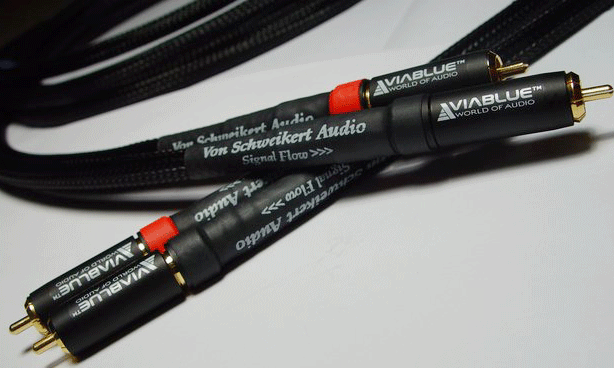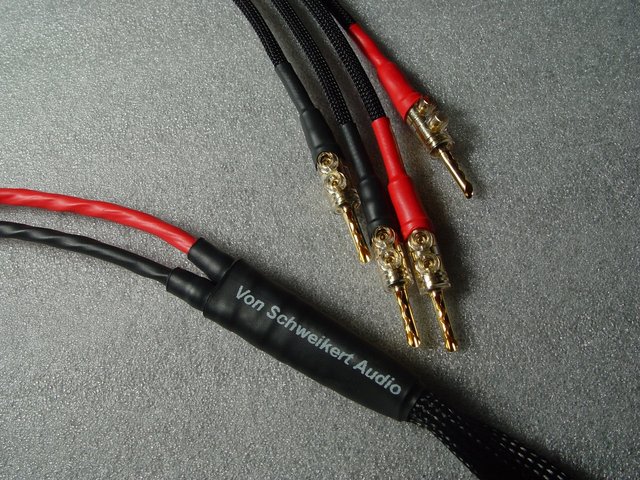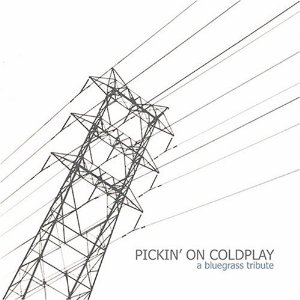Von Schweikert Audio Cables
| Von Schweikert Audio Cables |
| The Master of Building Cables |
|
|
|
September 2011 |

Master Built by Delphi Aerospace
Though best known as a speaker designer, Albert Von Schweikert is not a newcomer to cable technology. As the Sales Director to Harmonic Technology back in 2000, Albert first introduced me to the “single crystal” technology commonly used in most cable designs today. Initially, development of Von Schweikert Audio (VSA) cables was driven to include the best components in VSA speaker systems. VSA cables were borne out of eight years of research in areas of metallurgy, electric field effects, and dielectric materials by Delphi Aerospace in collaboration with Albert Von Schweikert. Although not well known, Delphi Aerospace is also contracted to supply cabling for the space shuttle program and the International Space Station.
For me, the two most important attributes that define cable performance are resolution and transparency. By resolution I mean the ability for the cable to convey the fine details of the music encoded in the recording, while transparency refers to a cable’s ability to present an “unclouded window” on the music, free of distortions and colorations. These characteristics are important for any audio component. Some cables offer a balanced presentation across the entire frequency spectrum while other cables are tilted toward either in the low, mid, or higher frequencies while other cables have high distortion resulting in the masking the inner details. In the past, I have been guilty of using cables as tuning devices to correct shortcomings in one or more components in my system. Although I am not a cable lover by nature, I am convinced that cables are an integral and synergistic part of any audio system and can make or break one.
From the white paper on the VSA cables, VSA cables are designed with the following goals: a) no coloration or distortion, b) wide band width and high dynamic range by reducing the resistance as close to zero as possible, and c) extended soundstage such that the musical signal is not compressed in height, width, and depth of the recorded soundstage. To achieve these goals, VSA has found that (1) the cable design must not generate any type of magnetic field distortion as a result of cable geometry, (2) the cable must be made from laboratory grade cast single crystal Copper having 99.9999% purity, (3) the insulation must be made of vacuum deposited Teflon absent of fee radical electron formation to minimize dielectric absorption, (4) the individual wire strands must be insulated and wound in a spiral helical Litz configuration to cancel hysteresis, (5) high and low frequency signals must be separated or bi-wired to inhibit frequency modulation, and (6) the best connectors and solder alloys must be used to minimize contact resistance.

Two models of VSA speaker cables are offered and differ only in wire gage: Standard Bi-wire speaker cables (16 separated solid core strands, photo above) and the double shotgun Signature Bi-wire speaker cables (32 solid core strands). VSA speaker cables are available in custom lengths and can be configured as single or bi-wire wire cables to be used on any speaker system.
As with the speaker cables, there are two models of VSA interconnects: Master Built Standard and Signature interconnects. The Signature version uses even higher grades of wire, insulation, and connectors and receives cryogenic and high voltage treatments. VSA interconnects are available in custom lengths and are offered in single ended RCA and balanced XLR configurations.
In this review I first evaluated the combination of VSA Signature bi-wire speaker cables and interconnects against other cables I have on hand. Secondly, the VSA Standard bi-wire speaker cables and VSA Standard interconnects were compared to the VSA Signature bi-wire speaker cable and VSA Signature interconnects.
Review System
My reviewing system has undergone some major changes as of late. I’ve gone from an all TacT Audio system with digital amplification, all digital interconnects and room correction powering Escalante Design Pinyons to the Ayon Audio Triton integrated tube amplifier running in pure Class A powering the award winning VSA Unifield 3. Having made to changes and optimizing my system accordingly, I can emphatically say I would never go back. I always felt something was missing in the foundation of the music in the former system. Some of the short comings in my former system included a type of distortion in the harmonic frequencies resulting in a veiling in the music and a lack of transient response. In my search to achieve the proper system synergy I have discovered some note worthy tweaks such as Herbie’s Audio Lab Ultrasonic Preamp tube dampers, HAL-O jr interconnect damping devices, Audio Prism Ground Control devices, and the extraordinary Shuguang Black Bottle KT88-Z power tubes. Part of my search to build a new reviewing system included the evaluation of various cable offerings from Audioquest and Nordost. My search was driven by the fact that my previous reference cables were not compatible with my new system being mainly related to the use of silver plating and the VSA Unifield 3 being voiced for copper. Although my previous reference cables were extremely transparent in their presentation they also highlighted the high frequencies in the new reviewing system.
My reviewing system includes the Ayon Audio CD player, Nova Physics Memory Player with the V-cap upgrade (latest version), Pioneer bdp-09fd blu ray player, Ayon Audio Triton integrated amplifier fitted with Shuguang Black Bottle KT88-Z power tubes and Mullard CV4003 signal tubes, Von Schweikert Unifield 3 loudspeakers, Escalante Design Pinyon loudspeakers and Audioquest speaker cables and interconnects. One set of Reference Audio Prism Ground Control devices was installed on the Von Schweikert Unifield 3s and the Ayon Audi Triton respectively. Herbie’s Audio Lab Preamp Ultrasonic tube dampers were installed on the Mullard CV4003 input tubes of the Ayon Audio Triton. As for my listening area, its 14.5’ wide, has a 9’ ceiling, and has an open back wall to 1500 sq ft of living area.
Resolution and Transparency in Spades  With the Signature speaker cables and interconnects installed, I started my evaluation listening to Clocks and Spies by ColdPlay, from their CD Pickin’ on ColdPlay (CMH Records). Within both of these recordings, I could clearly hear and place the banjo, mandolin, guitar, fiddle and upright bass as distinct instruments with unnerving liquidity, truthfulness, and dynamic contrasts. I’ve listen to these recording hundreds of times and have never heard each instrument displayed with such sharp focus and depth/width of soundstage. Individual notes seamed to float in three dimensional space achieving new levels of clarity, coherence and transparency comprising the whole of the musical event. These same qualities were duplicated while enjoying Diana Krall, Quiet Nights (The Verve Music Group) with Diana’s voice out in center having greater presence than ever before.
With the Signature speaker cables and interconnects installed, I started my evaluation listening to Clocks and Spies by ColdPlay, from their CD Pickin’ on ColdPlay (CMH Records). Within both of these recordings, I could clearly hear and place the banjo, mandolin, guitar, fiddle and upright bass as distinct instruments with unnerving liquidity, truthfulness, and dynamic contrasts. I’ve listen to these recording hundreds of times and have never heard each instrument displayed with such sharp focus and depth/width of soundstage. Individual notes seamed to float in three dimensional space achieving new levels of clarity, coherence and transparency comprising the whole of the musical event. These same qualities were duplicated while enjoying Diana Krall, Quiet Nights (The Verve Music Group) with Diana’s voice out in center having greater presence than ever before.
 Listening to cut 3 and 6, Robert Plant/Alison Krauss, Raising Sand(Rounder), the mid and lower bass performance of the VSA Signatures reached the lowest depths as compared to my reference cable system while maintaining excellent pitch definition. On both cuts, Alison’s voice was presented in a most natural way emanating from its source and expanding in all directions. With the VSA Signature cables I could clearly perceive the microdynamic shading in Alison’s vocal voice which added to the enjoyment of the performance.
Listening to cut 3 and 6, Robert Plant/Alison Krauss, Raising Sand(Rounder), the mid and lower bass performance of the VSA Signatures reached the lowest depths as compared to my reference cable system while maintaining excellent pitch definition. On both cuts, Alison’s voice was presented in a most natural way emanating from its source and expanding in all directions. With the VSA Signature cables I could clearly perceive the microdynamic shading in Alison’s vocal voice which added to the enjoyment of the performance.
In comparison to the Nordost Tyr interconnects and Valkyrja speaker cables, the VSA Signature cables excelled in both resolution and transparency. They have a way of expressing the emotion in the music in a most natural way. Their tonal balance was accurate yet smooth across the entire frequency range with more textural information than the other cables auditioned. The VSA Signature cables and Unifield 3 speakers complimented each other but I see no reason that they wouldn’t integrated well with any other reference speaker system. I confirmed this when I reinstalled the Escalante Pinyon loudspeakers in the system chain. The VSA Signature cables maintained their character of having the proper tonal balance which allowed me to enjoy the Escalante Pinyon loudspeakers in a new way.
As revealing as they are together, they can also easily expose any short coming in one’s system. For example, before inserting the VSA Signature cables, I couldn’t decide on certain songs if upsampling was the best setting via the Ayon Audio CD-2. After installing the VSA Signatures cables I could clearly detect the best setting depending on each disc. My one complaint concerning VSA cables is related to product identification. Although the model types are clearly marked on the interconnect offerings, the product name was absent on both speaker cables. But based on the number of shotgun runs and weight of the cables, it was easy to differentiate the two speaker cable models.
When I swapped from the VSA Signature cable set (speaker cables and interconnects) to the VSA Standard cable set, the VSA Standard cables performed well in all aspects as discussed above within its price point. I found the VSA Signature cables to be more resolving across the entire frequency range with greater micro/macro dynamics while listening Clocks and Spies, ColdPlay, Pickin’ on ColdPlay a bluegrass tribute (CMH Records). While the banjo, mandolin, guitar, fiddle and upright bass were portrayed as distinct instruments on these recordings with the VSA Standard cables inserted in my system, each instrument had more inner detailed and impact with the VSA Signature cables installed. On cut 3 of Robert Plant/Alison Krauss, Raising Sand (Rounder), the VSA Signature cables reached lower in the bass frequencies with less strain also. The VSA Standard speaker cable and VSA Standard interconnects were comparable in performance to the other cables auditioned but stood out as having a more natural tone.
Conclusion
Any audio system is only as good as its weakest link. With VSA Signature cables residing in one’s system, rest assured, cabling will not be your weakest link. Albert Von Schweikert’s goal was to design a cable that would not alter the original signal in any way. I believe Albert achieved this goal. Highly recommended.

![]()
Specifications:
VSA Standard Bi-wire Speaker Cable:
• 4 separate cable “runs” per jacket, separated at the speaker end by 36”
• 12 gauge
• Diameter, 0.75’
• Spade lugs or banana plugs Viablue
• black or light gray nylon jacket
Retail price/8 foor pair: $3,500
VSA Signature Bi-wire Speaker Cable:
• 8 separate cable runs per jacket, separated at the speaker end by 36”
• 9 gauge
Retail price/8 foor pair: $6,000
VSA Standard Interconnect:
• connectors Viablue
• black or light gray nylon jacket
Retail price/meter pairRCA:$1,250
Retail price/meter pairXLR:$1,600
VSA Signature Interconnect:
• connectors Furutech FP-106R
• black or light gray nylon jacket
Retail price/meter pairRCA:$3,500
Retail price/meter pairXLR:$3,750
Address:
Von Schweikert Audio
1040-A Northgate Street
Riverside, CA 92507
(951) 682-0706
Website: www.vonschweikert.com
Email: customerservice@vonschweikert.com
![]()
Don’t forget to bookmark us! (CTRL-SHFT-D)
Stereo Times Masthead
Publisher/Founder
Clement Perry
Editor
Dave Thomas
Senior Editors
Frank Alles, Mike Girardi, Key Kim, Russell Lichter, Terry London, Moreno Mitchell, Paul Szabady, Bill Wells, Mike Wright, Stephen Yan, and Rob Dockery
Current Contributors
David Abramson, Tim Barrall, Dave Allison, Ron Cook, Lewis Dardick, Dan Secula, Don Shaulis, Greg Simmons, Eric Teh, Greg Voth, Richard Willie, Ed Van Winkle, and Rob Dockery
Music Reviewers:
Carlos Sanchez, John Jonczyk, John Sprung and Russell Lichter
Site Management Clement Perry
Ad Designer: Martin Perry





Be the first to comment on: Von Schweikert Audio Cables